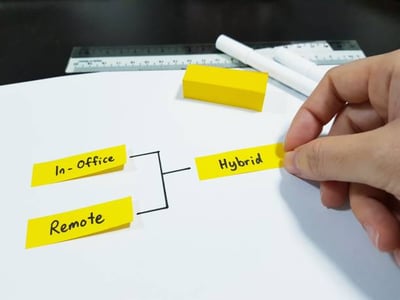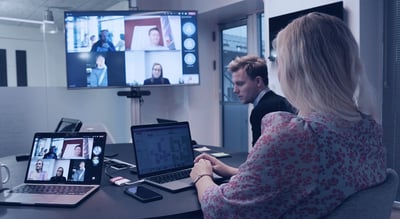July 28, 2022
 by Dayana Mayfield / July 28, 2022
by Dayana Mayfield / July 28, 2022

The world has gone hybrid.
Employees and customers need the flexibility to switch between working from the comfort of their homes and physically in an office. With hybrid events, learning, healthcare, and shopping on the rise, you may wonder how to adapt your communication strategies to this new way of life.
Let’s delve deeper into the research behind hybrid living, set the stage for customer and employee expectations, and present different strategies for you to adapt to a hybrid world quickly and successfully.
Only 30% of companies surveyed in Buffer's State of Remote Work 2019 said they support remote work. But this was before the pandemic forced businesses to work from home.
Many companies found that, contrary to what executives had previously believed, productivity and collaboration were not negatively impacted. But now, according to Buffers State of Remote Work 2022, 56% of organizations surveyed are willing to work fully remotely, and 41% favor hybrid remote work or spending part-time in the office and home.
All in all, the average number of days worked from home worldwide has quintupled since the pandemic. Remote and hybrid employees demonstrate higher productivity and experience better work-life balance. As the world opens up again, employees are demanding to retain the flexibility that full-time or part-time remote work offers.
Source: Whereby
A hybrid working model will be the dominant format in the future as hybrid adopters are usually startups and scale-ups. Sixty-three percent of high-revenue companies use a hybrid working model, and 83% of all employees prefer this working style. Meanwhile, 56% of all companies worldwide now allow remote work.
The pandemic hasn’t only changed the lives of employees but also customers. For example, the number of people using a telehealth service increased from 17% before the pandemic to 46% after.
Consumers now want greater convenience when shopping as well. Hybrid shopping experiences, which combine virtual and online shopping channels, are on the rise. Twenty-seven percent of all consumers and 36% of Gen Zs use hybrid shopping to purchase something online and pick it up in-store or order an item in the store to be delivered at home.
For example, Sephora is known for delivering various digital and in-person experiences, including a loyalty program that offers online and in-store purchases, VIP shopping days, in-store orders, in-store pickup, free returns, and pickup, including in-house samples for most products.
Source: Sephora
College education, hobby learning, and other events are taking place online. People are slowly returning to in-person events but still prefer virtual and hybrid experiences.
Additionally, customers demand experiences that meet their needs and expectations. They want to switch between face-to-face and online communication as they see fit. You need to consider every touchpoint, communication channel, and experience you offer and map out where better hybridization is possible.
People expect to work in a hybrid way, whether on duty or off the clock. Both B2B and B2C companies need to adapt to this new work culture.
As unforeseen circumstances strike and customer expectations become more complex, companies that quickly adopt communications trends and technologies will be better off.
To continue adapting to changing expectations, you need to take stock of the technologies already in place that could positively impact the customer experience, work life, or other business-critical aspects. The proliferation of smartphones, laptops, and high internet connectivity encourages lifestyle flexibility, and you should be prepared to deal with this change.
Sixty percent of employees say it is difficult, very difficult, or impossible to get the information they need from their colleagues to do their job. In the hybrid world, the simple Kanban boards that were popular in the early '00s are no longer enough to manage projects and tasks.
Luckily, remote work communication and project management platforms have evolved. Apps like Jira, ClickUp, Monday.com, and Scoro offer advanced collaboration tools beyond tracking task status.
Here's an example of how Monday.com can help you visually plan resources and project stages:
Source: Monday.com
Some top features that advanced project management tools offer:
Because you can track all the details of a project, they also improve the transparency essential for hybrid work. As employees move between home and office, they can find everything they need to do their jobs. So make sure you use a collaboration platform that centralizes communication, task management, and asset storage.
A video calling API is a perfect solution if you need to bring conversations and appointments online to accommodate a hybrid lifestyle.
A video API is a subscription-as-a-service that adds video calling functionality to your mobile or web app. Video calling can help you build better customer engagement because it's an authentic way to communicate with someone when you're not physically in the same room.
Using a video chat API means purchasing video calling capabilities from another software company and embedding them into your digital experience. This is far more affordable than building them from scratch, as software developers specializing in real-time communication are rare.
The options are endless for both B2B and B2C experiences.
You can also add a chat API to your app or website to provide chat functionality without in-house developing technology. Chat APIs support e-learning apps, e-commerce websites, remote work collaboration tools, and dozens of other digital platforms.
You can provide chat capabilities for remote workers and customer support purposes or even allow customers to chat with each other.
A text messaging API has many use cases and is essential to your arsenal when delivering hybrid virtual experiences. Text messages reach users when they’re not logged into your app or website and have the highest success rate of any communication tool.
Ninety-seven percent of text messages are read within 15 minutes of delivery. This is why virtual messaging channels should be reserved for important messages so you don’t annoy your audience.
SMS messages can be used for transaction confirmations and security, such as a two-factor authentication code. Text messaging is also great for appointment reminders. Telemedicine professionals' no-show rates are lower than missed appointments at doctor visits, most likely because it's so easy to reschedule appointments online. SMS reminders can help reduce the no-show rate even further.
Text messages are also great for parcel delivery notifications as they can help reduce parcel theft. Consider the most important communication you have with colleagues and customers. Then build in text capabilities for multichannel success.
As more aspects of life move online, it's important to balance them with personal experiences. That's what hybrid living is all about.
If your business is primarily remote, consider a mix of in-person and virtual team-building activities. For example, you could host an annual company retreat so people can connect on a more human level and offer a few virtual team-building experiences throughout the year. Platforms like Upduo and Donut algorithmically connect different people in an organization so they can get to know and mentor one another.
Team members can host virtual happy hours monthly to take time out for non-work-related conversations. Consider sending gift baskets or wine and cheese pairings in advance to thank the staff for their hard work.
Of course, networking and community-building events are not just for internal business purposes. Businesses can also adapt to the new hybrid way of life by offering a variety of experiences to their customers.
For example, nut milk brand Silk offered virtual eco-anxiety counseling for Earth Day. MAC Cosmetics has long been offering 10-minute mini makeovers to willing participants on the streets of San Francisco, New York, and other cities.
From brand activations and influencer-only events with non-stop social content to live Q&A streams with accredited experts, brands can do a lot to meet their audiences no matter where they are.
Several technologies are set to accelerate hybrid trends and lead even more people to a hybrid way of working and living. Satellite internet will improve global internet coverage and speed, making remote work, appointments, and shopping more convenient and feasible for people living in rural or remote areas.
We’ll also see more companies, particularly large slow movers, adopt a hybrid style and allow at least a day or two of remote work. As Gen Z consumers are more likely to embrace hybrid shopping experiences, we will see more brands offering these experiences as they try to capitalize on Gen Z's rapidly growing spending power.
The good news is that all of these trends point to a time of heightened creativity and ingenuity. People will work together to improve comfort, not just for the sake of it, but to improve work-life balance and have more time for the people and activities they truly love.
Making your employees feel valued and addressing their needs is critical to your company's bottom line. Learn more about how you can optimize your employee experience.
Dayana Mayfield is a B2B SaaS copywriter who believes in the power of content marketing and a good smoothie.
The pandemic has caused work-from-home (WFH) initiatives to skyrocket, and they show no signs...
 by Dan Bladen
by Dan Bladen
Hybrid models are the future of the workplace.
 by Annabel Benjamin
by Annabel Benjamin
As much as there is to gain from hybrid work there is also something to lose.
 by Allan Moerch
by Allan Moerch
The pandemic has caused work-from-home (WFH) initiatives to skyrocket, and they show no signs...
 by Dan Bladen
by Dan Bladen
Hybrid models are the future of the workplace.
 by Annabel Benjamin
by Annabel Benjamin


